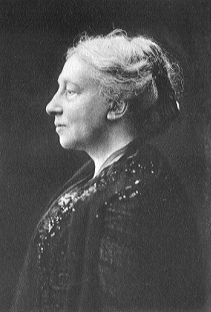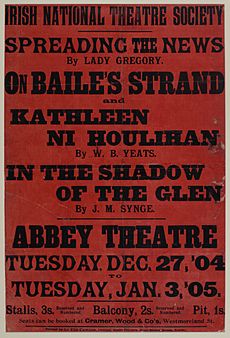Lady Gregory facts for kids
Quick facts for kids
Lady Gregory
|
|
|---|---|

Lady Gregory pictured on the frontispiece to "Our Irish Theatre: A Chapter of Autobiography" (1913)
|
|
| Born |
Isabella Augusta Persse
15 March 1852 Roxborough, County Galway, Ireland
|
| Died | 22 May 1932 (aged 80) |
| Resting place | New Cemetery in Bohermore, County Galway, Ireland |
| Occupation | Dramatist, folklorist, theatre manager |
| Years active | 1882 to 1932 |
| Known for | Co-founder of the Abbey Theatre, collection of folklore, playwright |
|
Notable work
|
Irish Literary Revival |
| Spouse(s) | |
| Children | William Robert Gregory |
| Relatives | Sir Hugh Lane (nephew) |
Isabella Augusta, Lady Gregory (born Persse; 15 March 1852 – 22 May 1932) was an important Irish writer, storyteller, and theatre manager. She helped start the famous Abbey Theatre in Dublin with William Butler Yeats and Edward Martyn. Lady Gregory wrote many short plays and retold old Irish myths.
She is best known for her work with the Irish Literary Revival. This was a movement to bring back Irish culture and language. Her home, Coole Park in County Galway, was a popular meeting spot for many famous writers. Lady Gregory believed in thinking wisely but speaking simply, like everyday people.
Contents
Lady Gregory's Life Story
Growing Up and Getting Married
Lady Gregory was born in Roxborough, County Galway. She was the youngest daughter in the Persse family, who were wealthy landowners. Her family's large estate, Roxborough, covered about 6,000 acres.
She was taught at home. Her nanny, Mary Sheridan, was a Catholic and spoke Irish. Mary taught young Augusta about local history and old legends, which greatly influenced her future writing.
On 4 March 1880, she married William Henry Gregory in Dublin. Sir William was 20 years older and had been the Governor of British Ceylon (now Sri Lanka). He was also a Member of Parliament for County Galway.
Sir William loved books and art. Their home at Coole Park had a huge library and art collection, which Lady Gregory enjoyed exploring. They also had a house in London where they hosted weekly gatherings. Many famous writers and artists, like Robert Browning and Henry James, visited them.
Their only child, Robert Gregory, was born in 1881. He sadly died as a pilot in World War I. This event inspired some of W. B. Yeats's famous poems, including "An Irish Airman Foresees His Death."
Early Writings and Travels
The Gregorys traveled a lot, visiting places like Sri Lanka, India, Spain, Italy, and Egypt.
Lady Gregory's first published work was Arabi and His Household (1882). This was a pamphlet supporting Ahmed 'Urabi, an Egyptian leader fighting for his country's freedom. She later wrote other pieces, including an anonymous pamphlet against a proposed law for Irish self-rule.
She also wrote short stories using the name "Angus Grey." After her husband, Sir William Gregory, passed away in 1892, Lady Gregory returned to Coole Park. She edited his autobiography, which was published in 1894. She later said that being a widow gave her the time and focus needed to write.
Becoming an Irish Nationalist
In 1893, a trip to Inisheer in the Aran Islands sparked Lady Gregory's interest in the Irish language and local folklore. She started Irish lessons at the school in Coole and began collecting stories from people in her area.
This led to several books of folk tales, such as A Book of Saints and Wonders (1906) and The Kiltartan Wonder Book (1910). She also retold Irish myths, like those in Cuchulain of Muirthemne (1902) and Gods and Fighting Men (1903). She wrote these in "Kiltartanese," her term for English that used Irish sentence structures.
While working on her grandfather-in-law's letters, Lady Gregory learned a lot about Irish history. This changed her political views. She moved from supporting British rule to strongly supporting Irish nationalism and independence. She later described this as a "dislike and distrust of England."
Starting the Abbey Theatre
In 1896, Lady Gregory met W. B. Yeats at her neighbor Edward Martyn's home. Their discussions led to the creation of the Irish Literary Theatre in 1899. Lady Gregory helped raise money for the theatre.
This first theatre project ended in 1901 due to lack of money. But in 1904, Lady Gregory, Martyn, Yeats, John Millington Synge, and others formed the Irish National Theatre Society. They found a new building on Lower Abbey Street in Dublin.
The theatre officially opened on 11 May 1904. Lady Gregory's own play, Spreading the News, was performed on the opening night, 27 December 1904.
In January 1907, there were riots during the opening of Synge's play The Playboy of the Western World. Lady Gregory defended Synge and the theatre, seeing it as a fight for artistic freedom.
Later Years and Legacy
Lady Gregory remained an active director of the Abbey Theatre until 1928, when she retired due to poor health. During this time, she wrote over 19 plays, mostly for the Abbey. Many of these plays used the "Kiltartanese" dialect, which was based on how people spoke around Coole Park.
Her plays were very popular in the early years of the Abbey. She also wrote a two-volume study of local folklore called Visions and Beliefs in the West of Ireland (1920).
Coole Park remained her home while she worked at the Abbey. She often stayed in hotels in Dublin, where she would interview new playwrights and host parties after opening nights. She also spent many days working on her translations at the National Library of Ireland.
After retiring from the Abbey board, Lady Gregory returned to live in Galway. Coole Park continued to be a gathering place for writers of the Irish Literary Revival. On a tree in the grounds, you can still see the carved initials of famous writers like Synge, Yeats, and George Bernard Shaw. Yeats wrote five poems about Coole Park.
In 1932, Lady Gregory passed away at home at the age of 80 from breast cancer. She is buried in the New Cemetery in Bohermore, County Galway. Coole Park was sold and its contents auctioned after her death, and the house was torn down in 1941.
Although her plays are not often performed today, her diaries and journals provide a valuable look into Irish literary history. Her retelling of the Ulster Cycle tales in Cuchulain of Muirthemne is still highly regarded.
In recent years, there have been new exhibitions and plays celebrating Lady Gregory's work. In 2020, Trinity College Dublin announced that a bust of Lady Gregory would be added to its library, honoring her as one of four important women.
Lady Gregory's Published Works
- Arabi and His Household (1882)
- Over the River (1888)
- A Phantom's Pilgrimage, or Home Ruin (1893) (published anonymously)
- Sir William Gregory, K.C.M.G., Formerly Member of Parliament and Sometime Governor of *Ceylon: An Autobiography (editor 1894)
- Mr. Gregory's Letter Box 1813–1830 (editor 1898)
- Casadh an t-súgáin; or, The Twisting of the Rope (translator 1902)
- Cuchulain of Muirthemne: The Story of the Men of the Red Branch of Ulster (Irish folk tales 1902)
- Poets and Dreamers: Studies and Translations from the Irish by Lady Gregory (1903)
- Gods and Fighting Men: The Story of the Tuatha de Danann and of the Fianna of Ireland (1904)
- Kincora: A Drama in Three Acts (1905)
- Spreading the News, The Rising of the Moon By Lady Gregory. The Poorhouse by Lady Gregory and Douglas Hyde (1906)
- The Hyacinth Galvey: A Comedy (1906)
- A Book of Saints and Wonders, Put Down Here by Lady Gregory According to the Old Writings and the Memory of the People of Ireland (1907)
- Seven Short Plays: Spreading the News. Hyacinth Halvey. The Rising of the Moon. The Jackdaw. The Workhouse Ward. The Travelling Man. The Gaol Gate (1909)
- The Kiltartan History Book (1909)
- The Kiltartan Molière: The Miser. The Doctor in Spite of Himself. The Rogueries of Scapin. Translated by Lady Gregory (1910)
- Spreading the News (1911)
- The Kiltartan Wonder Book by Lady Gregory (1911)
- Irish Folk-History Plays, 1st series. The Tragedies: Grania – Kincora—Dervorgilla (1912)
- Irish Folk-History Plays, 2nd series: The Tragic-Comedies: The Canavans – The White Cockade – The Deliverer (1912)
- New Comedies: The Bogie Men; The Full Moon; Coats; Damer's Gold; McDonough's Wife (1913)
- Damer's Gold: A Comedy in Two Acts (1913)
- Coats (1913)
- Our Irish Theatre – A Chapter of Autobiography (1913)
- The Unicorn from the Stars: And Other Plays, by W.B. Yeats and Lady Gregory (1915)
- Shanwalla (1915)
- The Golden Apple: A Play for Kiltartan Children (1916)
- The Kiltartan Poetry Book: Prose Translations from the Irish (1919)
- The Dragon: A Wonder Play in Three Acts (1920)
- Visions and Beliefs in the West of Ireland Collected and Arranged by Lady Gregory: With Two Essays and Notes by W.B. Yeats (1920)
- Hugh Lane's Life and Achievement, with Some Account of the Dublin Galleries. With Illustrations (1921)
- The Image and Other Plays (Hanranhan's Ghost; Shanwalla; The Wrens(1922)
- Three Wonder Plays: The Dragon. Aristotle's Bellows. The Jester (1922)
- Plays in Prose and Verse: Written for an Irish Theatre, and Generally with the Help of a Friend, by W. B. Yeats and Lady Gregory (1922)
- The Story Brought by Brigit (1924)
- Mirandolina (1924)
- On the Racecourse (1926)
- Three Last Plays: Sancho's Master. Dave. The Would-Be Gentleman (1928)
- My First Play (Colman and Guair) (1930)
- Coole (1931)
- Lady Gregory's Journals (1947)
- Seventy Years, 1852-1922, Being the Autobiography of Lady Gregory (1974)
- The Journals. Part 1. 10 October 1916 – 24 February 1925 (1978)
- The Journals. Part 2. 21 February 1925 – 9 May 1932 (1987)
- Lady Gregory's Diaries 1892-1902 (1996)
- Lady Gregory's Early Irish Writings 1883-1893 (2018)
See also
 In Spanish: Lady Gregory para niños
In Spanish: Lady Gregory para niños
- Cathleen Ní Houlihan





